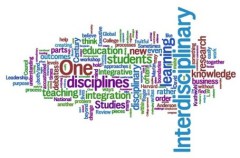- Dahlke et al.,Theorizing Interdisciplinarity, Center for Science in Society, Bryn Mawr College, © 1994-2014.
- Mansilla, V.B. & Dawes, E. (2007). Targeted Assessment of Students’ Interdisciplinary Work: An Empirically Grounded Framework Proposed: Journal of Higher Education, 78 ( 2), pp. 215-237
- Mansilla, V.B. et al. (2009). Targeted Assessment Rubric: An Empirically Grounded Rubric for Interdisciplinary Writing: Journal of Higher Education, 80 (3), pp. 334-353, and assessment grid.
- Mansilla, Veronica B., “Assessing Student Work at Disciplinary Crossroads,” Change 37, no. 1 (2005):14-21.
- McCoy, Shannon K. & Susan K. Gardner, “Interdisciplinary Collaboration on Campus: Five Questions,” November-December 2012.
- Wiggins G. and J. McTighe, Understanding by Design [2nd ed.], Pearson Publishing, 2005, 384 p. (Chapter 1, recommended). See also: UdB.
- SERC Literature and Resources for Interdisciplinary and Integrative Learning
- Elrod, Susan and Roth, Mary J.S, 2012, Leadership for Interdisciplinary Learning: A Practical Guide to Mobilizing, Implementing, and Sustaining Campus Efforts, AAC&U Publishing.
- How to inspire interdisciplinarity, The Guardian blog, posted by Elizabeth Dzeng, 3/15/13.
- Interdisciplinary Approaches to Teaching (HTML)
- Assessment Rubric for Interdisciplinary Learning in an Integrative Experience
- Interdisciplinary Curricula—Recommended Literature Resources
Discussion Points and Considerations for Interdisciplinary Teaching: Motives, Methods and Institutional Realities
Drawing upon contemporary literature resources about the applications and aims of interdisciplinary learning and teaching, faculty and students may achieve great insights through academic examination and deliberation about the approach itself. The SAIL seminar considered the following questions and assertions.
– What is interdisciplinarity? What is it not? What motivates interdisciplinarity?
– What are the intrinsic rewards for interdisciplinarity?
– What impediments exist to interdisciplinary learning? Are their practicalities or entrenched ways that are limiting us?
– Within the span of a semester, quarter, or block, can students achieve sufficient understanding and functionality within a single discipline, much less multiple disciplines? Is it possible to have sufficient depth in each discipline that is to be applied? Is interdisciplinarity amateurish, less professional, because it is not as specialized? Within the time available, how can we avoid reducing the foundational knowledge, best practices, and intellectual framework of each discipline in order to have acquaintance with multiple disciplines?
– How can we be conscious of our process in achieving interdisciplinarity? How can we track the steps by which we acquire or discover new knowledge, and achieve important realizations? How best to flag and tag what we are doing as we do it?
Talking points: • Interdisciplinary modes offer a “solution to a crisis”: there are questions we need to answer and disparate disciplines are no longer adequate to address these questions. • Mansilla et al. observe a clear demand for interpreting forms of knowledge effectively. • Working interdisciplinarily comes naturally to faculty scholars and is fundamental to doing research; however the ability to do this grows with experience. Students need guidance so that they can understand how to identify relationships as they acquire information, and how to synthesize knowledge. • Motivation comes from scholarly excitement about new discoveries and realizations that come from interdisciplinarity. How do we instill this sense of scholarly excitement to our students?
Institutional considerations
What people are able to do interdisciplinary work? Who are good faculty for this? What kinds of students are good at this? McCoy and Gardner’s Questions and Categories reduce to three major categories: people, policies, and resources.
What administration is necessary? Policies, etc? What kinds of resources are needed? (TIME, Space, Funds…)
Students take classes in a variety of fields, hence they have skill sets and contextual knowledge, and a degree of interdisciplinary training in their majors and general education. How best to mobilize this knowledge and catalyze interdisciplinary work?
Talking points: • Advising may play a major role in directing students’ interdisciplinarity, hence broad awareness and experience by faculty members is critical. • Time is a major issue : time is required for reading, reflection, integration, and preparation of materials of value from discplines outside of our own field. • Are there opportunities to reinvigorate rather than spend time creating anew?
